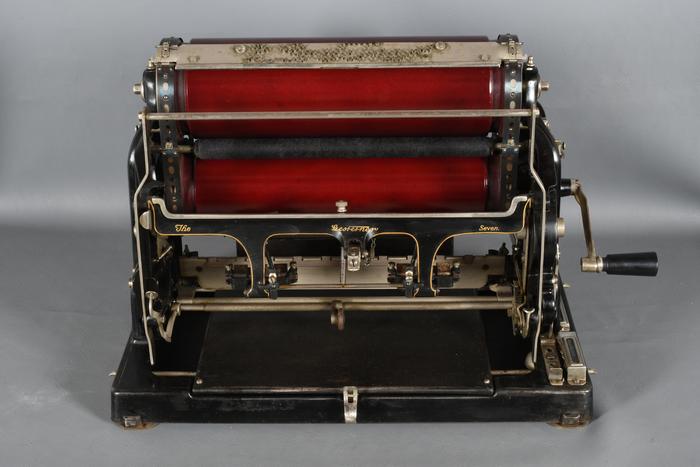Reprodutor a stencil
Ciência e Tecnologia
David Gestetner
- ProdutorTítulo Alternativo:
Stencil duplicatorDescrição:
Este reprodutor a stencil é o modelo nº 7 de um aparelho inventado e patenteado por David Gestetner, em 1879. Gestetner nasceu na Hungria, em 1854, e, ainda muito jovem, foi viver e trabalhar para Viena, no setor de stocks (Swain, 2013). A sua função era copiar, por escrito, os registos das atividades efetuadas diariamente. Deste modo, com o objetivo de tornar a tarefa mais rápida, prática e fiável, desenvolveu, entre outros, um aparelho denominado Gestetner Cyclostyle Machine, que revolucionou totalmente o funcionamento de diversos negócios, indústrias e instituições de diferentes setores (Swain, 2013; Victorian Collections, 2019). Esta invenção possibilitava a reprodução de diversas cópias de documentos, através do uso de um stencil, que era uma folha de papel fino coberto por uma camada de cera, e de uma caneta perfurante com a ponta em metal, a Cyclostyle pen, também patenteada por Gestetner, em 1881 (Victorian Collections, 2019). O facto de as cópias serem mecanicamente iguais levava a que não fosse necessária revisão.Em primeiro lugar, colocava-se o stencil na armação inferior do copiador com placa de metal, de forma a, por perfuração, criar uma matriz do texto a copiar. Posteriormente, o stencil já perfurado passava para a armação superior, sendo inserida, na armação inferior, uma folha em branco. O próximo passo consistia em rolar o cilindro, à mão, para espalhar a tinta no stencil, de modo a transferir o texto. Por fim, o papel impresso era retirado e introduzido outro (Victorian Collections, 2019).
David Gestetner foi viver para Londres, em 1879 (English Heritage, sd), e, na primeira década do século XX, abriu a Gestetner Works, que laborou durante várias décadas, tendo tido, nas de 50 e 60, milhares de funcionários (Swain, 2013).
Doação da Direção das Obras Públicas de Angra do Heroísmo, em 1978.
This stencil copier is the model number 7 of a machine invented and patented by David Gestetner in 1879. Gestetner was born in Hungary, in 1854, and still very young he went to Vienna to live and work in the stock management area (Swain, 2013). His job was to copy, by writing it, the registers of the daily activities developed. Therefore, to make that job quicker, practical and reliable, he developed, among others, a machine named Gestetner Cyclostyle Machine, which completely changed the industries, institutions and business operations (Swain, 2013; Victorian Collections, 2019). This invention allowed the reproduction of several document's copies, though the use of a stencil, a thin sheet of paper covered by a wax layer, and the use of a piercing pen with a metal end, the Cyclostyle pen, also patented by Gestetner, in 1881 (Victorian Collections, 2019). The fact that the copies were mechanically identical meant that no revision was needed.
At first, the stencil was put in the lower frame of the copier, with a metal plate, in a way that, though the piercing, it would create a matrix of the text to be copied.
Afterwards, the stencil, already pierced, was placed in the upper frame and a blanck sheet was inserted in the lower frame. The following step consisted in rolling the cylinder by hand in a way that the ink would be scattered over the stencil to transfer the text. At the end, the printed paper was removed and other would be put in the copier (Victorian Collections, 2019).
David Gestetner went to live in London in 1879 (English Heritage, sd) and, in the twentieth century´s first decade, he opened the Gestetner Works, which was in business during over six decades and, in some of them, had thoundands of workers (Swain, 2013).
Donation from the Direção de Obras Públicas de Angra do Heroísmo (local Public Renovations Department), in 1978.


